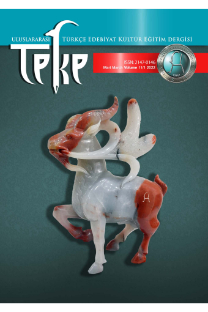Tatar Dili Şivelerindeki Fiilin Bazı Arkaik Geçmiş Zaman Biçimleri
Tatar dilinin bütün şivelerinde ve ağızlarında kullanılan ve birçok Türk dilinde rastlanan -dı, -ğan biçimleri zengin semantik ve fonksiyonel potansiyele sahiptirler. Geçmiş zamanın yukarıda anılan biçimlerinin kullanılmasından dolayı Tatar şiveler dili hiçbir Türk dilinden farklı değildir, aksine onlarla aynı kökten olduğu kanıtlanmaktadır. Bundan başka Tatar dili ağızlarında geçmiş zamanın fonksiyonel ve semantik bakımdan çeşitli derecede olan ve Tatar halkının, onun ağızları tarihinin çeşitli dönemlerinde ortaya çıkan başka biçimlerine de rastlanır. Lengüistik coğrafya bakımından onlar çeşitli biçimdeki ve yoğunluktaki izoglosları meydana getirmektedirler. Genellikle bu fiil biçimleri dil ve etnik ilişkiler sonucunda ortaya çıkan alanlarda meydana gelen alt birimleri teşkil ederler. Mesela, -ıp(tı), -ulı, -ğanda biçimleri bunların başında gelirler.
Anahtar Kelimeler:
Türk dilleri, Kazan Tatarları, Tatar dili, şive dili, ağızlar, geçmiş zaman
A Some Archaic Verb Forms of Past Tense in Subdialects of Tatar Language
Forms with –dy /(–??), -gan /(-???), which are used in all dialects and subdialects of Tatar language and typical for the majority of Turkic languages, distinguish themselves by their rich semantic content and their multifunctionality. The Tatar dialect language is not opposed by usage of mentioned above forms of Tatar language to any Turkic languages but only shows its common Turkic basis. Besides of all, there are forms of Past Tense in subdialects of Tatar language with different degree of usage activity and semantic spreading, appeared in different periods of formation of Tatar nation and its various subdialects. From the linguistic geography point they form isoglosses of different configuration and intension. As a rule such verb forms present substrate phenomenon that arouse from language and ethnic interactions. First of all, these are the forms with –yp (ty)/ –?? (??), - uly/ -???, - ganda /-?????. The study of verbal forms of subdialects of the Tatar language using system-synchronous method allowed to conclude that the form with –gan/–???, which is extensively used in all the subdialects, in the first place is typical for the subdialects of the Kazan Tatars (subdialects of the middle dialect). Their formation begins during the Bulgarian period. Despite the fact that the form of the past tense with –gan/–??? is specific to many Kipchak languages, area of distribution of competitive forms with –yp/–??, - uly/-??? is wider. They are quite actively used in many Turkic languages within their various groups. In the first conjugation of third person, it is the dominant form in Kazakh, Nogai, Karachay-Balkar, Uzbek, Kyrgyz, in some Turkic languages of Siberia. These past-tense forms are known in Uighur, Turkmen, Yakut, Azerbaijani languages. The article concludes that, in contrast to the common Turkic forms with –dy/–??, -gan /-???, it is revealed in the history that it is emerged in outlying subdialects of the Tatar language as a result of the influence of some neighboring Kipchak languages. According to the use the form with –ganda/–????? Tatar dialectic language sharply contrasted with the rest of the Turkic languages. The article concludes that, in spite of this fact, this form is formed based on the model of the Turkic languages.
Keywords:
Turkic languages, Kazan Tatars, Tatar language, dialects, subdialects, past tense,
___
- AGANYAN, L. S. (1962). Ob odnom armyano-kipçakskom grammatiçeskom posobii XVI veka. Voprosı Yazıkoznaniya, №5.
- BASKAKOV, N. A. (1940). Nogayskiy Yazık i Yego Dialektı, Moskva-Leningrad.
- BASKAKOV, N. A. (1956). Sistema spryajeniya ili izmeneniya slov po litsam v yazıkax Tyurkskoy gruppı, Sravnitelnaya Grammatika Tyurkskix Yazıkov. Morfologiya, Moskova.
- BLAGOVA, G. F. (1976). İmena deystviya v tyürkskix yazıkax sredneaziatskogo regiona. Tyurkologiçeskiye İssledovaniya, Moskva, s. 68.
- GADJİYEVA, N. Z. (1976). Tyurkoyazıçnıyı Arealı Kavkaza, Moskva.
- İVANOV, S. N. (1969). Rodoslovnoyo Drevo Tyurok Abu-l Gazi-hana... Grammatiçeskiy Oçerk (İmya i Glagol. Grammatiçeskiye Kategorii), Taşkent.
- FAZILOV, E. İ-ZİYATOVА, M. T. (1978). İzıskannıy Dar Tyurkskomu Yazıku. Grammatiçeskiy Traktat XIV Veka Na Arabskom Yazıke. Vvedeniye, LeksikoGrammatiçeskiy Oçerk, Perevod, Glossariy. Grammatiçeskiy Ukazatel, Taşkent. KAYDAROV, A. T. (1966). Uygurskiy (novouygurskiy) yazık. Yazıki Narodov SSSR, T. , Tyurkskiye Yazıki, Moskva, 363-386.
- KONONOV, A. N. (1960). Grammatika Sovremennogo Uzbekskogo Literaturnogo Yazıka, Moskva.
- KONONOV, A. N. (1969). Rodoslovnaya Turkmen. Soçineniye Abu-l-Gazi Hana Hivinskogo, Moskva.
- KORKİNA, Y. İ. (1970). Nakloneniya Glagola v Yakutskom Yazıke, Moskva.
- NASİLOV, V. M. (1940). Grammatika Uygurskogo Yazıka, Moskva.
- URUSBİYEV, İ. H. (1963). Spryajeniye Glagola v Karaçayıvo-Balkarskom Yazıke, Çerkessk.
- ORUZBAYEVA, B. O. (1955). Formı Proşedşego Vremeni v Kirgizskom Yazıke, Frunze.
- ÇARIYAROV, B. (1969). Gunorta-Gunbator Türki Dillerde İşlik Zamannarı, Aşgabat, s. 2
- SADVAKASOV, G. (1976). Yazık Uygur Ferganskoy Dolinı, Alma-Ata.
- SEVORTYAN, E. V. (1966). Affiksı İmennogo Slovoobrazovaniya v Azerbaydjanskom Yazıke. Opıt Sravnitelnogo İssledovaniya, Moskva.
- Sovremennıy Kazahskiy Yazık (1962), Alma-Ata.
- ŞİRALİJEV, M. (1962). Azerbajcan Dialektologiyası Esasları, Baku.
- ŞUKUROV, Ş. İ. (1966). İstoriya Razvitiya Glagolnıh Form Uzbekskogo Yazıka, Taşkent.
- TURSUNOV, A. (1969). “Kategoriya vremeni glagola v kirgizskom yazıke”, Voprosı Kategorii Vremeni i Nakloneniya v Tyurkskix Yazıkax, Baku.
- ISSN: 2147-0146
- Yayın Aralığı: Yılda 4 Sayı
- Başlangıç: 2012
- Yayıncı: Cengiz Alyılmaz
Sayıdaki Diğer Makaleler
Tatar Dili Şivelerindeki Fiilin Bazı Arkaik Geçmiş Zaman Biçimleri
Ağız Atlaslarının Hazırlanışında Süreç, Yöntem ve Teknikler: Flaman Ağız Atlasları Örneği
Çağdaş Dil Biliminin Işığında Yeni Lisan Hareketi ve Türk Dil Devrimi’nin Karşılaştırılması
Türkiye’de Fuarcılığın İlk Adımlarından 1909 Bursa Sergisi
Özlem Ayazlı, Altun Yaruk Sudur VI. Kitap (Karşılaştırmalı Metin Yayını)
Tenkit ve Teori Konusunda Boşluğu Dolduran Kılavuz Bir Eser: Eski Türk Edebiyatında Tenkit ve Teori
Vilnius Üniversitesinde “Uluslararası Türk Tarihi ve Kültürü Sempozyumu” Yapıldı
